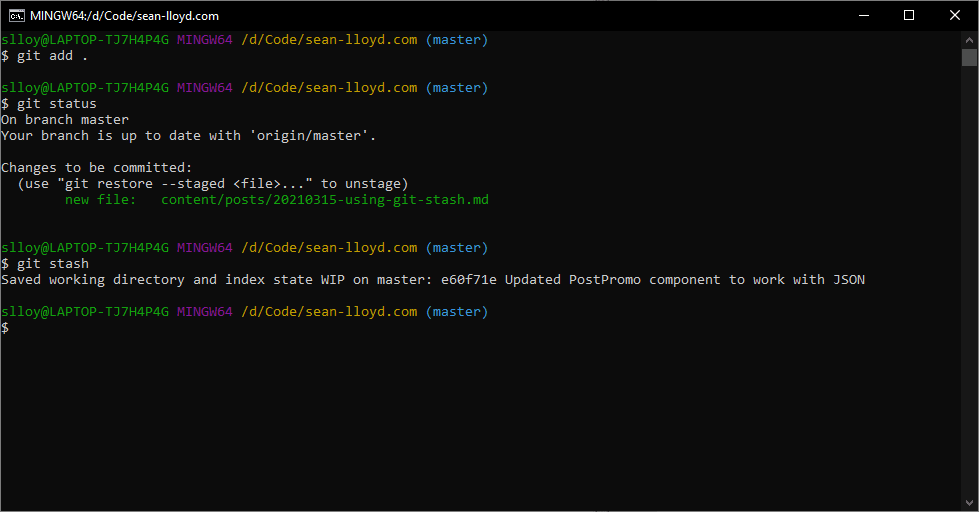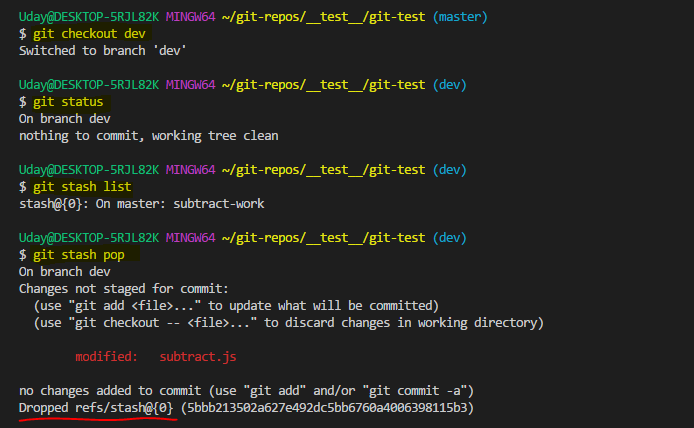

The pop will apply the latest saved change and remove it from the list. # git stash popĭropped (7184c69236e4926f9fc8c78aa35ff705eb5a1e6e)Ĭheck if temporary changes are applied.

Once the bug is fixed, it’s time to move to the original point that you have left.īring changes from the temporary location to the working tree.
#Git stash commands how to#
How to move back to the temporary change?

To do that, you must run the git stash apply command with a -index. the index older is the saved point and the most recent one is with zero. The changes to your files were reapplied, but the file you staged before wasnt restaged. If there are multiple points at which you have stashed the changes it will look like the following. Nothing to commit, working directory cleanĬheck what has been stashed? # git stash WIP on master: cf3ea37 Merge Saved working directory and index state WIP on master: cf3ea37 Merge The above changes are temporary and you can not commit, but you need to go to the original state for a quick fix. The git stash command shelves changes you have made to your working copy so you can do another work, and then come back and re-apply them. No changes added to commit (use "git add" and/or "git commit -a") You can add changes to ignored files as well by using the -a option (or -all) when running git stash. " to discard changes in working directory) In these cases, the git stash -u option (or -include-untracked) helps to stash the untracked files. How to use git stash explained with example? Check what local changes have been done with the git status command and save them with the git stash.Ĭheck what has been modified. Preethi-Dev/gitstashcommands.md Stash the changes Stash the untracked files List the stashes show the latest stash Show the individual stash Apply the.
#Git stash commands code#
This will not add any dirty commitment to the working code line. You can later apply the local changes made during the update. You can use the git stash command to save local changes and revert to the code’s original state before performing a git pull to retrieve the changes. If you want to view the diff of changes for each stash, you can use the -p option: git stash list -p. git stash list -before 5.days.ago git stash list -after 5.days.ago. After that switch to work with the original local directory having temporary changes. If you want to search the git stash history based on a date range, you can use the git stash list before and after options. To do that, you must run the git stash apply command with a -index option to tell the command to try to reapply the staged changes.One method is to check out the code in a new location and make changes and push. Lab setup to practice git discard changes. The changes to your files were reapplied, but the file you staged before wasn’t restaged. Git commit HEAD, uncommitted and committed changes explained. Git stash drop To delete a specific stash from list. Git stash apply To apply a specific stash from list. Git stash show: To see what n is in the below commands. Git stash list: To list your stashed changes. Git stash apply: To apply recent saved stash. Its not possible to push a stash to a remote repository. Git stash or git stash push To save your changes in a stack. Stashing is like saving a temporary local commit to your branch. Stashing takes the your modified tracked files and staged changes and saves it on a stack of unfinished changes that you can reapply at any time even on a different branch.īelow are commands to work with stash on git:

git stash takes a snapshot of the current state of your. In such situations git stash command is very useful. Command Description git stash: git stash is used to save the changes in present working directory: git stash apply: this command is used to apply the changes which you have saved before with the command git stash: git stash list: this command list all the stashed changes: git stash drop: this command delete the recent stashed chnages. Stashing lets you store your in-progress work and retrieve it later, without committing it to a branch. The problem is that you don’t want to do a commit of half done work so you can get back to this point later. Review the following Git commands most commonly used in any developers workflow.
Tuck away files and work on them later with git stash. When you have been working on part of your project and things are in a messy state and you want to switch branches for some other work. git checkout feature git rebase master git stash. Stashing is a phenomenon that is meant to temporarily store the files/content safely Git also supports this feature, and it is recognized as Git stash.


 0 kommentar(er)
0 kommentar(er)
